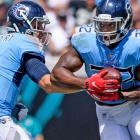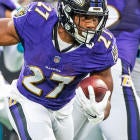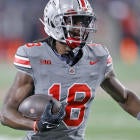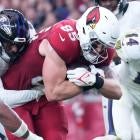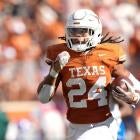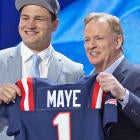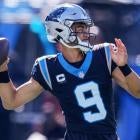Every year, the most uninspiring "starting" running backs, stuck in subpar situations and with dubious claims to a lead back designation, are available in the middle and later single-digit rounds.
And every year, we fall for them.
I blame one of my favorite offseason tools: projections. By nature, projections reduce a range of potential outcomes down to a single number, which can lead to false optimism about players with elevated risk in their projected workloads. That issue creeps in most notably at running back, where the size of a workload is key — and can disappear in an instant.
Take Alex Collins, a top-100 Fantasy pick in 2018 mostly because it wasn't clear who could challenge him for touches. Collins was the beneficiary of it being near impossible to project undrafted free agent Gus Edwards for 137 carries before the season. But players like Edwards emerge time and again, and drafters rarely learn the lesson that a lack of clarity in August does not mean a player like Collins has secure touches.
Collins was a best guess, because in a projection, those running back touches have to be assigned to someone. He wasn't the only one. Jay Ajayi, Jamaal Williams, Carlos Hyde and Rashaad Penny had similarly tenuous projections, though in some cases we felt confident in the backup — it was just difficult to predict that backup to lead the backfield.
In 2017, Ty Montgomery, Eddie Lacy, Paul Perkins, Ameer Abdullah, Rob Kelley and Terrance West were all taken in the first 10 rounds of drafts. The year before, names like Jeremy Langford, Ryan Mathews, Matt Jones, Justin Forsett and Arian Foster — the post-Achilles, Dolphins version — all fit this description to varying degrees.
A significant percentage of those backs are no longer in the NFL.
Any given season, the top 15-20 backs have more secure projections thanks to the offenses they play in, their own skills or both. Outside that range, drafters are left picking through pass-catchers coming off a spike season, a few of the highest-upside backups, and these uninspiring projected lead backs. Or, as I like to call it: "The Running Back Dead Zone."
Here's the kicker: Even the backs in this range who do stay healthy and keep their jobs rarely possess elite upside. In most drafts, this dead zone starts by Round 4, sometimes even Round 3, and will last through the single-digit rounds.
Testing this theory
This is a difficult thing to test. There are issues with using full-season Fantasy points, because few running backs play 16 games. There are issues with using points-per-game, even with a limit to games played, because missing any more than one or two games starts to become pretty significant. There are issues with applying win rate data from best ball formats to a redraft analysis, because we'd rather be targeting backs that are peaking late than peaking early, and best ball typically views all weeks equivalently.
Additionally, win rates are influenced by many factors outside the performance of the player we're trying to analyze. Take Devonta Freeman's remarkable 2015 season, when he finished as the overall RB1 after being taken in the 10th round on average. Because 2015 was such a down year for running back production, Freeman finished 50 PPR points clear of Adrian Peterson's RB2 season. But in each of the three seasons since, at least two backs have outperformed Freeman's PPR total from that season. Last year, five did.
I'd argue it's almost irrelevant that 2015 was such a down year for running back production around Freeman, and we should instead try to zero in on the points he posted from a 10th-round Average Draft Position.
Because of these concerns, rather than use a single metric, I stole from what data scientists would call an ensemble method in more advanced analyses, where they apply multiple algorithms to attack a data set in different ways.
Looking at all running back seasons in the past 10 years, I first used a simple cutoff for total PPR points of 280, which isolated the top 41 single-season performances of the past 10 years.
Next, I looked at points per game for players who played at least half the season but didn't make it the full 16 games. The full-season cutoff of 280 points is the equivalent of 17.5 points per game over 16 games, but for this points-per-game cutoff, I raised the bar to 20 points per game. This pulled in another seven backs like Melvin Gordon and Kareem Hunt in 2018 and Ezekiel Elliott in 2017, who played at least half the season and were well on their way to 280-point seasons, but fell short because of missed time.
Finally, to try to capture short-but-elite late-season performances, I used an even higher cutoff of the equivalent of 23 points per game to look at the Fantasy playoff weeks (Weeks 14-16). The cutoff for this group was 69 (nice) total points over the three-week span. That pulled in eight more late-season league-winners like Damien Williams and Derrick Henry from 2018 to give us a final group of 56 running backs over the past 10 seasons whose Fantasy performances could be described as elite.
The results
My goal in pulling this cohort was to simply see where in drafts these elite performances came from. Unsurprisingly, the majority were top picks.
Of this group, 33 (59%) were drafted in the first two rounds, while another five were Round 3 picks.
But the results immediately after that point are fascinating. Just seven backs in this group had ADP from the start of Round 4 through the end of Round 9.
The ADP data I used, pulled from MyFantasyLeague 12-team PPR leagues, went through Round 16. Nine of these backs came from Round 10 through Round 16, roughly the same-size sample. (The final two were undrafted.)
This seems almost unbelievable. But it gets back to the concepts I discussed in the intro, as well as what I wrote about Tuesday: how touch mix can help you determine which backs to target and which to avoid. Part of the reason drafters are good at identifying the top 15 or 20 most valuable backs is it's relatively obvious that receiving value and touchdown equity create monster Fantasy potential. In this dead zone, though, drafters are taking not just lead backs with tenuous grips on starting roles, but also ones with far less reception upside and touchdown potential.
What does this mean?
In Fantasy drafts, we should strive to make decisions that will either miss little or hit big. But most running backs in the middle or late double-digit rounds profile as either big misses or little hits. Drafters have proven good at recognizing the backfield situations that are worst among the NFL's 32 teams, but because we have to project someone to lead those backfields, and because it's often too early to take shots on potential breakout running backs, the dead zone exists.
It's my opinion that an equitable draft board would still see running backs go near the top, as they do now. But starting in about the middle of Round 3 or certainly by Round 4, all drafters in a given league would start to gravitate toward other positions, particularly wide receiver. Later in the single-digit rounds, it would start to make sense to target backs that typically go in these earlier single-digit rounds, because they do provide safer floors than the late-round dart throw running backs we typically take in the double-digit rounds.
But that is impractical, and not what the market reflects. Actual leagues don't draft running backs with this barbell-like approach: heavy in the first couple rounds, lean for several, then heavy again. Since that is not our reality, the solution is simple: don't draft many running backs in the dead zone.
Instead, target running backs early (or don't, and go full Zero RB), then fill out your backup running back slots late. Much like NFL draft analysis has shown the surest way to increase hit rate is to stockpile more picks, leaving your running back depth chart to be filled out in the later rounds means more bites at that late-round apple, hoping to land the 2019 version of 2018 James Conner or 2017 Alvin Kamara.
If you're concerned about early-season production and want to lock in safe points, you can still find that in the double-digit rounds by mixing in cheap pass-catchers like Nyheim Hines, Jalen Richard or Dion Lewis who have depressed ADPs due to a perceived lack of upside. Often, I plan to start a player like this in the early part of the season while I wait for something among my plethora of upside bets (or my early-season waiver wire work) to pan out.
While this is an obvious weakness at the start of the season, the other major advantage to forgoing running backs in the majority of the single-digit rounds is your roster will be stacked at every other position. It helps that this season there is an absolute gold mine of young wide receiver talent throughout the dead zone: D.J. Moore, Tyler Boyd, Chris Godwin, Calvin Ridley, Christian Kirk, Mike Williams, Will Fuller, Dante Pettis and Curtis Samuel are just some of the names you can target.
You can still compete, and your roster can get stronger throughout the year. You can take shots on these high-upside wide receivers because you'll have depth to support you if they fail. All you have to trade off is a little more security in the form of higher running back picks that make you feel better about your roster on Draft Day but don't actually move the needle toward winning you a championship.
Armed with the information in the touch mix article Tuesday as well as this, we can zoom in on some specific backs to stay far away from at their ADPs, as well as the best late-round options to target, in my next piece.



















